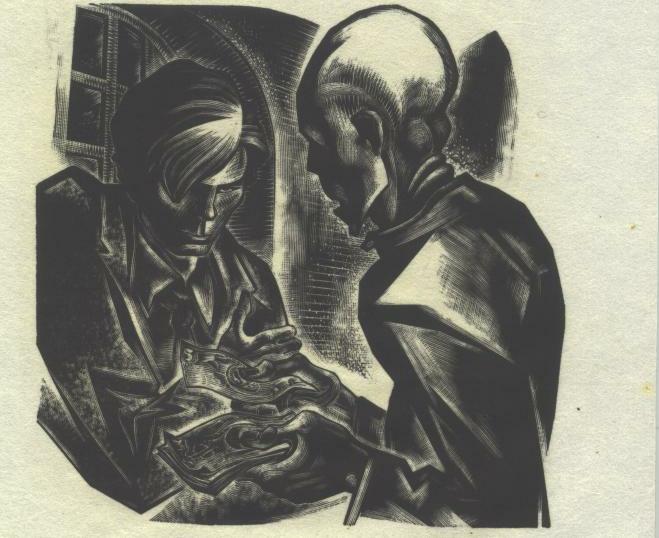End Notes to Exhibition of Lynd Ward's 2" x 2" Size Blocks for Vertigo
1. The fortune teller's booth constitutes one of the most important and poignant passages in Vertigo, in which the two young heroes visualize the ideal destinies they will never achieve. It is also one of only two passages articulated by a sequence of three small (2" x 2") images, conveying a sense that time has momentarily been annulled. BACK
2. There are 11 occurrences of two or more medium sized images in succession: 6 occurrences of sequences of two, and 1 occurrence each of a sequence of three, four, eleven and sixteen images. (By comparison, there only 8 occurrences of a sequence of two or more small blocks: 5 sequences of two, 2 sequences of three, and 1 sequence of five.) BACK TO 40BACK TO 08-10
3. Philippe Aries, The Hour of Our Death, trans. Helen Weaver (New York: Alfred A. Knopf, 1981), 393, qtd. in Dan Meinwald. "Memento Mori: Death and Photography in Nineteenth Century America." http://www.cmp.ucr.edu/terminals/memento_mori/intro.html. Meinwald notes, "Aries owes a considerable (and acknowledged) debt to Georges Bataille for these ideas." BACK
4. Lynd Ward's Last Unfinished Wordless Novel. New Brunswick: Rutgers University Special Collections and University Archives; New Jersey Book Arts Symposium, 2001. BACK
5. In this respect, Vertigo has affinities with other novels on the undying or undead, including Goethe's Faust and Mary Shelley's Frankenstein-both books that Ward illustrated during the 1930s. (1930 and 1934, respectively). The Elderly Gentleman suggests another kind of unnatural monster-albeit one with a conscience. BACK
6. The transition from a jumbo image to a small occurs five times in the "Elderly Gentleman" section and twice in "The Boy" section. Correspondingly, the transition from small to jumbo occurs twice in every section. Of related interest, a small block begins the chapter twice (both times in the "Elderly Gentleman" section), and ends a chapter three times (twice in the "Elderly Gentleman" section and once in "The Boy" section). Each of the two times a small block ends one of the "Elderly Gentleman" chapters, the preceding image is a jumbo image. The one time a small block ends a chapter in another section, the preceding image is also a small image, although the image preceding that is jumbo. To complete this kind of analysis, of the two times a small image begins a chapter, once it is followed by a jumbo image and once a large. Bearing in mind that the "Elderly Gentleman" section includes about twice as many small images the other sections (10/19/11), one might observe that the most profound contrasts occur within this section, and that this volatility accords well with our understanding of the Elderly Gentleman's volatility and inner struggle. BACK
7. This image follows a jumbo image, structurally replicating the pair of images that have immediately preceded them and concluded the "February" chapter, suggesting that the inner turmoil depicted in I94 and reinforced by the sudden contrast between I93 and I94, remains, and perhaps has even gained intensity. There is also the hint in this radical oscillation of the violence to come. BACK
8. Theodore Adorno. "The Culture Industry: Enlightenment as Mass Deception," in Dialectic of Enlightenment (New York: Continuum, 1993). BACK
9. Maria Lohan. "Men, Masculinity and the Domestic Telephone: a Theoretical Framework for studying Gender and Technology." BACK
10. Perhaps Ward's intended the hour-glass as an allusion to Bunyan, whose reference to the workman would have appealed to his feeling for the value of work, and whose symbolic sense of the calendrical year is reconstituted in the chapter headings of the "Elderly Gentleman" section. BACK
This glass when made, was by the workman's skill
The sum of sixty minutes to fulfill.
Time more nor less by it will out be spun
But just an hour, and then the glass is run.
Man's life, we will compare unto this glass
The number of his months, he cannot pass.
But when he has accomplished his day.
He, like a vapour, vanisheth away.
11. See http://caselaw.lp.findlaw.com/data/constitution/amendment18/, and https://constitution.findlaw.com/amendment21.html.) BACK
12. In 2000, 16,653 highway fatalities, or 40 percent of all highway fatalities, involved alcohol. Bureau of Transportation Statistics. Fact of the Day. BACK
13. Lawrence A. Greenfeld. "Alcohol and Crime: An Analysis of National Data on the Prevalence of Alcohol Involvement in Crime," prepared for the Assistant Attorney General's National Symposium on Alcohol Abuse and Crime, April 5-7, 1998: p. 4. BACK
Michael Scott Joseph
January 2003
Special Collections and University Archives
Rutgers University Libraries
Print view
